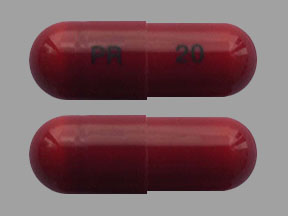Piroxicam Dosage
Medically reviewed by Drugs.com. Last updated on May 13, 2025.
Applies to the following strengths: 10 mg; 20 mg
Usual Adult Dose for:
Additional dosage information:
Usual Adult Dose for Osteoarthritis
20 mg orally once a day
- If desired: 10 mg orally twice a day
Comments:
- Potential benefits and risks of this drug and other therapeutic options should be carefully considered before deciding to use this drug.
- The lowest effective dosage should be used for the shortest duration according to individual patient treatment goals.
- Dose and frequency should be adjusted to suit an individual patient's needs after observing response to initial treatment with this drug.
- In older adult patients, if the anticipated benefit outweighs potential risks, dosing should be started at the low end of the dosing range.
Uses: For relief of signs/symptoms of osteoarthritis and rheumatoid arthritis
Usual Adult Dose for Rheumatoid Arthritis
20 mg orally once a day
- If desired: 10 mg orally twice a day
Comments:
- Potential benefits and risks of this drug and other therapeutic options should be carefully considered before deciding to use this drug.
- The lowest effective dosage should be used for the shortest duration according to individual patient treatment goals.
- Dose and frequency should be adjusted to suit an individual patient's needs after observing response to initial treatment with this drug.
- In older adult patients, if the anticipated benefit outweighs potential risks, dosing should be started at the low end of the dosing range.
Uses: For relief of signs/symptoms of osteoarthritis and rheumatoid arthritis
Renal Dose Adjustments
Mild or moderate renal dysfunction: No adjustment recommended
Severe renal dysfunction: Data not available
Advanced renal disease: Avoid use unless the benefits are expected to outweigh the risk of worsening renal function.
- If this drug is used: Monitor patients for signs of worsening renal function.
Liver Dose Adjustments
Liver disease: Dose reduction may be required; however, no specific guidelines have been suggested.
If clinical signs/symptoms consistent with liver disease develop or if systemic manifestations (e.g., eosinophilia, rash) occur during therapy: Discontinue this drug immediately and clinically evaluate the patient.
If abnormal liver tests persist or worsen during therapy: Discontinue this drug.
Dose Adjustments
Patients with severe heart failure: Avoid use unless the benefits are expected to outweigh the risk of worsening heart failure.
- If this drug is used: Monitor patients for signs of worsening heart failure.
Patients known or suspected to be poor CYP450 2C9 metabolizers based on genotype or history/prior experience with other CYP450 2C9 substrates (e.g., warfarin, phenytoin): Consider dose reduction.
Precautions
US BOXED WARNINGS:
- CARDIOVASCULAR THROMBOTIC EVENTS: NSAIDs cause an increased risk of serious cardiovascular thrombotic events (including myocardial infarction and stroke), which can be fatal; this risk may occur early in therapy and may increase with duration of use. This drug is contraindicated in the setting of coronary artery bypass graft (CABG) surgery.
- GASTROINTESTINAL (GI) BLEEDING, ULCERATION, AND PERFORATION: NSAIDs cause an increased risk of serious GI adverse events (including bleeding, ulceration, and perforation of stomach or intestines), which can be fatal; such events can occur at any time during use and without warning symptoms. Older adult patients and patients with history of peptic ulcer disease and/or GI bleeding are at greater risk for serious GI events.
CONTRAINDICATIONS:
- Known hypersensitivity (e.g., anaphylactic reactions, serious skin reactions) to the active component or any of the ingredients
- History of asthma, urticaria, or other allergic-type reactions after taking aspirin or other NSAIDs (severe, sometimes fatal, anaphylactic reactions to NSAIDs have been reported in such patients)
- In the setting of CABG surgery
Safety and efficacy have not been established in patients younger than 18 years.
Consult WARNINGS section for additional precautions.
Dialysis
Data not available
Other Comments
Administration advice:
- Before starting this drug, correct volume status in dehydrated or hypovolemic patients.
Storage requirements:
- Store at 20C to 25C (68F to 77F); excursions permitted to 15C to 30C (59F to 86F).
General:
- Due to the long half-life of this drug, steady-state blood levels are not reached for 7 to 12 days.
- While therapeutic effects are evident early in treatment, response progressively increases over several weeks; the effect of therapy should not be assessed for 2 weeks.
Monitoring:
- Cardiovascular: Blood pressure (during initiation and throughout therapy); for signs of worsening heart failure in patients with severe heart failure
- General: Chemistry profile (periodically during long-term therapy)
- Hematologic: CBC (periodically during long-term therapy)
- Renal: Renal function in patients with renal or liver dysfunction, heart failure, dehydration, or hypovolemia (during therapy); for signs of worsening renal function in patients with advanced renal disease
- Respiratory: For changes in signs/symptoms of asthma in patients with preexisting asthma
Patient advice:
- Read the US FDA-approved patient labeling (Medication Guide).
- Be alert for symptoms of cardiovascular thrombotic events (including chest pain, shortness of breath, weakness, slurring of speech); report any of these symptoms to your health care provider immediately.
- Report symptoms of GI ulcerations and bleeding (including epigastric pain, dyspepsia, melena, hematemesis) to your health care provider.
- If signs/symptoms of hepatotoxicity (e.g., nausea, fatigue, lethargy, pruritus, diarrhea, jaundice, right upper quadrant tenderness, influenza-like symptoms) occur, stop this drug and seek immediate medical therapy.
- Watch for symptoms of congestive heart failure (including shortness of breath, unexplained weight gain, edema) and contact your health care provider if such symptoms occur.
- Seek immediate emergency help if signs of anaphylactic reaction (e.g., difficulty breathing, swelling of face or throat) occur.
- Stop this drug immediately if any type of rash or fever develops and contact your health care provider as soon as possible.
- If pregnant, avoid using this drug and other NSAIDs starting at 30 weeks gestation; if this drug is needed between about 20 to 30 weeks gestation, you may need to be monitored for oligohydramnios if therapy continues beyond 48 hours.
- Concomitant use of this drug with other NSAIDs or salicylates is not recommended; do not use low-dose aspirin with this drug until you talk to your health care provider.
More about piroxicam
- Check interactions
- Compare alternatives
- Pricing & coupons
- Reviews (27)
- Drug images
- Latest FDA alerts (4)
- Side effects
- During pregnancy
- Drug class: Nonsteroidal anti-inflammatory drugs
- Breastfeeding
- En español
Patient resources
Other brands
Professional resources
Other brands
Related treatment guides
See also:
Further information
Always consult your healthcare provider to ensure the information displayed on this page applies to your personal circumstances.


